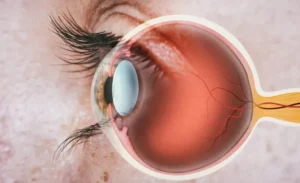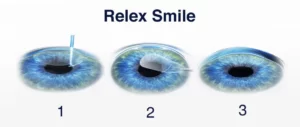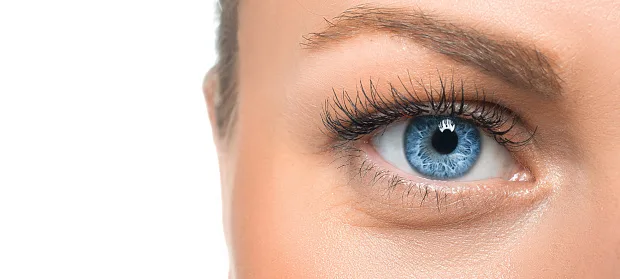Have you ever wished to wake up one morning and not have to reach for your glasses or fumble with contact lenses? With advancements in technology, that dream can now become a reality, and it’s all thanks to a procedure called SMILE. Today, we’ll talk about the new LVC procedure: SMILE, how it works, know who is the right candidate for it, and common side effects. So, without any delay, let’s dive in.
Contents
What is SMILE Procedure?
 SMILE, an acronym for Small Incision Lenticule Extraction, is a cutting-edge vision correction technology that has transformed the field of refractive surgery. By using state-of-the-art femtosecond laser technology, SMILE gently reshapes the cornea, the clear outer layer of the eye, correcting refractive errors like nearsightedness and astigmatism.
SMILE, an acronym for Small Incision Lenticule Extraction, is a cutting-edge vision correction technology that has transformed the field of refractive surgery. By using state-of-the-art femtosecond laser technology, SMILE gently reshapes the cornea, the clear outer layer of the eye, correcting refractive errors like nearsightedness and astigmatism.
The Importance of SMILE
The Small Incision Lenticule Extraction, or SMILE, is a breakthrough in refractive surgery, providing a solution for myopia (nearsightedness) and astigmatism. It offers several unique advantages that set it apart in the field of vision correction. Let’s delve into some of them:
- Less Invasive: SMILE is known for its ‘flapless’ procedure. Unlike LASIK, which creates a large flap on the cornea, SMILE uses a small incision, reducing the risk of complications like dry eyes and post-operative discomfort. This makes the procedure less invasive and reduces recovery time.
- Quick Recovery: With SMILE, most people can return to their daily activities within a couple of days. The recovery period is relatively quick, minimizing disruption to your life.
- Long-Lasting Results: SMILE has shown to provide stable and long-lasting correction for myopia and astigmatism. This means you can enjoy clear vision for a long time after your procedure.
- Greater Comfort: Many patients have reported experiencing less discomfort during and after the SMILE procedure compared to other laser vision correction methods.
- Quality of Life: Perhaps most importantly, SMILE has the potential to drastically improve your quality of life. Imagine the freedom of enjoying sports, travel, and everyday activities without the hassle of glasses or contacts.
How Does SMILE Work?
 The beauty of the SMILE procedure lies in its simplicity and precision. So, let’s break it down into a few straightforward steps to help you understand how it works:
The beauty of the SMILE procedure lies in its simplicity and precision. So, let’s break it down into a few straightforward steps to help you understand how it works:
- Preparation: Before the procedure begins, numbing drops are applied to your eyes to ensure you don’t feel any discomfort during the process. Then, a speculum is placed to keep your eyes open.
- Creating the Lenticule: Using a state-of-the-art femtosecond laser, the surgeon creates a tiny, lens-shaped piece of tissue (known as a lenticule) inside the cornea. This is done with extreme precision, and the laser settings are customized based on your unique refractive error.
- Accessing the Lenticule: Next, the same laser creates a small incision (usually less than 4mm) on the surface of your cornea. This incision gives the surgeon access to the lenticule.
- Removing the Lenticule: Through this tiny incision, the surgeon then delicately extracts the lenticule using a special instrument. This step is key: by removing this small piece of tissue, the shape of your cornea is altered.
- Reshaping the Cornea: The removal of the lenticule changes the way light is refracted, or bent, by the cornea. Essentially, it corrects the refractive error causing your myopia or astigmatism.
- Post-Procedure: Since the incision is so small, no stitches are required after a SMILE procedure. Your eye will heal naturally over time. Post-operative care typically involves eye drops to help with healing and prevent infection.
The entire SMILE procedure takes just a few minutes per eye. Despite its speed, it’s a highly sophisticated process that requires significant expertise and precision from your surgeon. The result? Improved vision that can liberate you from glasses or contact lenses, helping you see the world with fresh eyes.
Who is an Ideal Candidate for SMILE?
Just like any medical procedure, not everyone is a suitable candidate for the SMILE procedure. Certain factors determine whether or not you qualify. So, who is eligible for SMILE? Let’s find out!
Generally, you may be eligible for the SMILE procedure if you meet the following criteria:
- Age: You must be at least 18 years old. This is because the eyes continue to develop and change until early adulthood. Therefore, having the procedure too early might result in changes to your vision later on.
- Stable Refraction: Your glasses or contact lens prescription should have been stable for at least a year before the surgery. If it’s still changing significantly, it might be best to wait.
- Corneal Thickness: The cornea must have sufficient thickness to allow for the creation of the lenticule and the small incision.
- Healthy Eyes: Your eyes should be generally healthy. This means no active eye conditions like glaucoma or cataracts, and no history of corneal disease or corneal surgery.
- Overall Health: You should be in good general health. Certain systemic conditions like diabetes or autoimmune diseases can affect healing and may disqualify you from surgery.
Preparing for SMILE
Once you’ve been deemed a suitable candidate for SMILE and have decided to go ahead with the procedure, there are several steps you can take to prepare for the surgery. These steps are designed to ensure that your eyes are in the best possible condition for the procedure and to reduce the risk of complications. Here’s what you can expect:
Pre-Procedure Care
- Schedule Your Appointment: SMILE is an outpatient procedure that takes only a few minutes per eye, but you’ll need to arrange for someone to drive you home after the surgery as your vision may be blurry.
- Avoid Contacts: If you wear contact lenses, you’ll need to switch to glasses full-time for a few weeks before your surgery. Contact lenses can alter the shape of your cornea, which could affect the results of your surgery.
- Have a Pre-Procedure Examination: This comprehensive eye exam will allow your doctor to confirm your prescription and check for any eye conditions that might affect your surgery.
- Discuss Medications: If you’re taking any medications, make sure to discuss them with your doctor. Certain medications might need to be stopped before the procedure.
- No Makeup: On the day of the procedure, avoid wearing any makeup, creams, or perfumes. These can interfere with the surgery and increase the risk of infection.
By following these steps, you can ensure that you’re fully prepared for your SMILE procedure.
Post-Procedure Care
 Following your SMILE procedure, post-operative care plays a crucial role in ensuring a smooth and speedy recovery. It helps minimize any discomfort you might feel and reduces the risk of complications. Here are some tips to aid your recovery:
Following your SMILE procedure, post-operative care plays a crucial role in ensuring a smooth and speedy recovery. It helps minimize any discomfort you might feel and reduces the risk of complications. Here are some tips to aid your recovery:
- Rest: After the procedure, it’s important to take it easy. Try to rest your eyes as much as possible for the first few hours. Some patients find that sleeping for a few hours immediately after the procedure helps to minimize discomfort.
- Avoid Rubbing Your Eyes: Rubbing your eyes can interfere with the healing process and potentially dislodge the cornea, which could lead to complications. If you feel an itch or discomfort, use the prescribed eye drops instead of rubbing.
- Use Medication as Prescribed: Your doctor will provide you with antibiotic and anti-inflammatory eye drops. Be sure to use these as directed to promote healing and prevent infection.
- Avoid Water in Your Eyes: For at least a week after surgery, try to keep water out of your eyes. This includes when washing your face or taking a shower. This can help prevent infection.
- Stay Away from Dusty or Smoky Environments: Environments with dust, smoke, or pollen can irritate your eyes and hinder the healing process.
- Attend Follow-Up Appointments: Follow-up visits are crucial to monitor your healing progress and catch any potential complications early. Be sure to attend all scheduled appointments.
- Resume Activities Gradually: While recovery from SMILE is relatively quick, it’s still important to resume your regular activities gradually. Start with light activities, and if all feels good, you can slowly return to your normal routine.
By following these steps, you can ensure a successful recovery from the SMILE procedure, getting you back to clear, crisp vision as quickly and safely as possible.
Side Effects Of SMILE Surgery
 Just like any surgical procedure, SMILE too comes with potential risks and complications. Although it’s generally considered safe with a high success rate, it’s important to understand the possible side effects before making your decision. While rare, some people might experience temporary side effects after SMILE. These typically improve over time and can include:
Just like any surgical procedure, SMILE too comes with potential risks and complications. Although it’s generally considered safe with a high success rate, it’s important to understand the possible side effects before making your decision. While rare, some people might experience temporary side effects after SMILE. These typically improve over time and can include:
- Dry Eyes: This is one of the most common side effects after any form of laser eye surgery, including SMILE. Your doctor will typically provide lubricating eye drops to help manage this symptom.
- Glare or Halos: Some patients might notice glare, halos, or starbursts around lights, especially at night. This is usually temporary and tends to resolve over time as the eye heals.
- Fluctuating Vision: Your vision might fluctuate or be slightly blurry for a few days after surgery. This usually stabilizes as your eyes adjust to their new shape.
- Discomfort: Some patients report mild discomfort or a ‘gritty’ feeling in the eye immediately after surgery. This usually subsides within a few days.
Serious complications might include:
- Infection: Although rare, infections can occur after SMILE. This is why it’s important to use the prescribed antibiotic eye drops and avoid getting water in your eyes.
- Corneal Ectasia: This is a condition where the cornea bulges outward, causing vision problems. This is a very rare complication.
Conclusion
In the pursuit of clearer vision, SMILE emerges as a revolutionary procedure. Its minimally invasive nature, quick recovery times, and high success rates make it an attractive choice for those struggling with myopia or astigmatism. Yet, like all medical procedures, it’s important to consider the potential risks and to have a thorough discussion with a healthcare professional about your suitability for the procedure.
In the vast world of vision correction, SMILE is just one of many solutions available. Procedures like PRK, Femto Lasik, SMILE surgery, Standard lasik, ICL and Contoura vision vision are also viable options depending on your unique needs and circumstances. If you have any questions on Lasik surgery in Delhi, Lasik surgery cost and Lasik procedure, call us at 9711116605 or email at [email protected].


